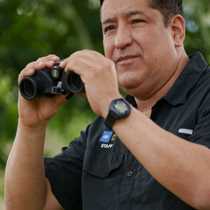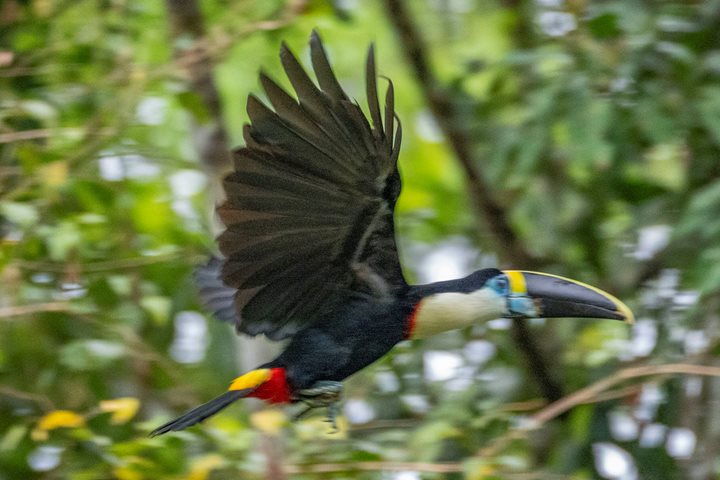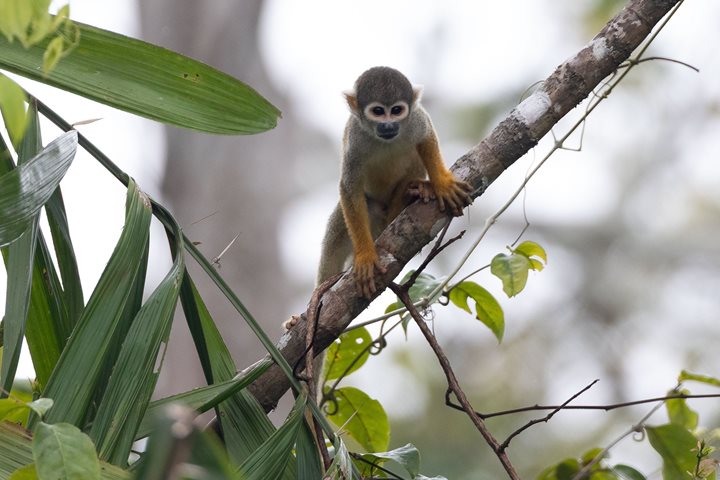Our expedition in the mighty Amazon started with high spirits today early in the morning with a wildlife exploration skiff ride. We explored a small creek tributary of the Marañon River called Parauachiro Caño. The latter local name “caño” is given to small streams and rivers that abound all over the area. Our first skiff ride was very successful for we spotted several species of tropical birds.
After a well-deserved breakfast we donned our rubber boots and went for a hike in the vicinity of the San Jose community, in an area known locally as Casual. We had the choice of a short walk or a longer hike. We had the company of three local native scouts from the community that helped us to locate wildlife along their well-maintained rain forest trail. This introductory walk let us understand, with the help of the knowledge of our naturalists, how fascinating the tropical rain forests in South America are.
We learned about some important plant species and observed and photographed several spiders, amphibians, and reptiles that our experienced scouts spotted. Two of these reptiles were amazing! One of them was an anaconda (Eunectes murinus murinus), which is one of the most iconic animal species in the Neotropics. We observed a juvenile that was around four feet in length. Adult anacondas can have been recorded reaching up to 30 feet in length but most are much smaller.
The other snake sighting was wonderful as well. We saw a rainbow boa (Epicrates cenchria). This mid-sized boa is one of the most beautiful snakes in the world. Its scaly body, when hit with the right strong light, reflects an iridescent rainbow of multiple vivid colors.
After the walk we came back on board to join a couple of introductory talks, one on the Amazon region and one on the Reserve. The Delfin II travelled from Casual to the Yanayacu River. This river is rich in tannins giving the peculiar and famous coloration of the inner rivers that are born as product of the copious rain that falls in the forests. These kind of rivers are aptly named black water rivers in opposite to white water rivers that are born in the Andes carrying immense quantities of sediments.
While having lunch we had the surreal thrill to observe many pink river dolphins joyfully fishing. Dolphins take advantage of the confusion fish experience while crossing from dark black water rivers to the muddy waters of the white water rivers. I know it is hard to do it but, can you imagine the experience of watching dolphins while having lunch? In the Amazon? Pink? Yes, they are here as living proof of the geological past of the region, when it was all flooded by a big lake that was formed at the same time as the Andes and the ancestral mountains that are still present in Brazil.
In the afternoon, after lunch, we explored the Pucate River, which is a black water tributary of the Marañon River. In this area, our fleet of trusty skiffs maneuvered by our “eagle-eyed” drivers allowed us to explore several very small creeks and lagoons in detail. Delfin II naturalist guides spotted many bird species, a few three-toed sloths and a couple of squirrel monkey troops.
Finally, late in the afternoon, we came back on board with unforgettable feelings and memories in our hearts and minds—the product of our first full day of our expedition this week in the Peruvian Amazon on board the Delfin II.







